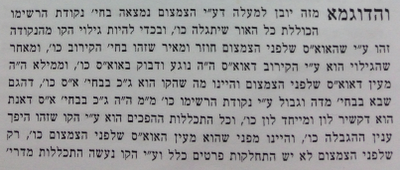AyinBase / Ayin Beis with R' Paltiel Sunday
28 Tishrei 5772
Page
169 – 4 lines from end of the page –
(line
starts, 'be-ohr ein sof...') For text, see picture below.
We
are working on the principle that on our level, when we talk of
chochmah/wisdom, it represents a paradox of great significance. On
the one hand there is a 'something'/metziut that is known. There is
'knowledge' that is separate, yet its presence depends completely on
its connection to its source.
So
there is in chochmah the combination of yesh/something and
ein/nothing, and hence there is a sense of the truth itself. And
similarly it has a feel that relative to this truth, all else is a
non-entity. All this other stuff exists due to its
presentation/effect and chochmah is relating to the truth itself.
Due
to our souls we have and experience a sense of reality that is not
'learned'. It is not due to external effect. It is a primary sense
of reality. Truth is present everywhere.
Breathing is the experience of life on a physical level. We don't
pull it in. The air comes in automatically. It is there. It is the
truth.
A
human being can recognize a certain intangible reality and nothing
can substitute for it.
If
the tzizum does not affect the light, so what is its effect? The
principle effect is regarding the vessels/keilim.
Let's
talk about keilim/vessels: even though we grasp things by means of a
vessel, there is a light in the vessel and we should relate to this
light primarily. A vessel is a means by which something is grasped.
Think of water in a cup. It has not changed by being in the vessel.
You
fill a cup from the ocean. This is an identification of an element
of limit from the limitless sea. The water in the cup is limited.
This is like the effect of the tzimzum on the light. It let's light
'trickle' in... but it is the same light.
The
vessel is what gives a real presence/metziut to the water or light.
The point is not
to limit the light, but to bring it into the level of world, and to
do this it must come via a vessel. And then the orientation must be
to focus on the reality of the light, not on the vessel.
The
light itself is not affected by the tzimzum, and it originates from
the ohr ein sof.
There
is a fine quality in light. We can see this in sechel/mind. There
are different ways to explain things – context, logic etc. You can
learn one thing and it will help you understand an unrelated topic.
This is because all sechel is rooted in the infinite light that
precedes the tzimzum. This is like the light. No limited how much
it is reduced is is based on and representative of the infinite light
that precedes the tzimzum (37min 15 sec of video).
If
not for the tzimzum/contraction the light would not be able to relate
to the worlds.
And
when the light is re-introduced after the contraction it is by means
of the 'trace'/reshimu. This gives the light a power of finitude.
All
sechel/mind is rooted in the ratzon/will and all levels of real
knowledge are inter-related. The only way we can draw a spark of
wisdom/chochmah, is if you focus in on a very specific principle.
There is not a spark that does not carry with it a specific message.
It addresses a certain question that is the initial focus.
This
is explaining how the general light comes through the 'point of a
trace'/nekudah reshimu.
This
points our the fallacy of trying, 'to find yourself' by contemplating
nothing. The point of all thinking is to bring wisdom into the human
faculties.
There
are people who see Judaism as too narrow and dry, and that is because
they don't realize that the way to the ocean is via a specific
stream...



































